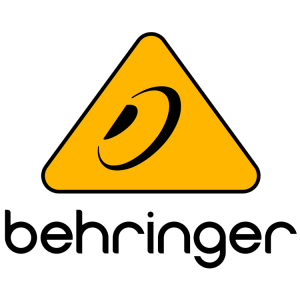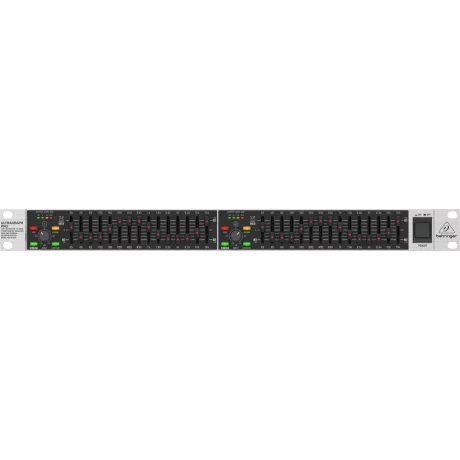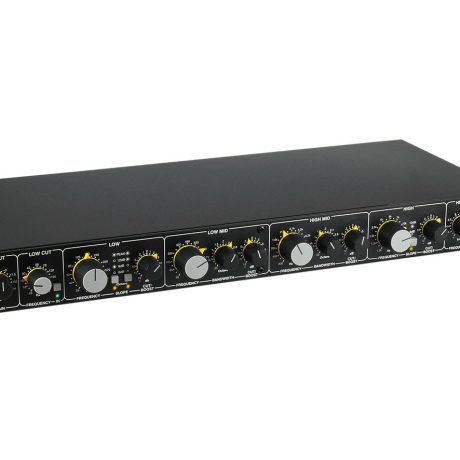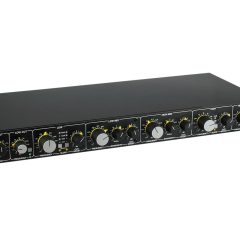| Content |
- Professional 15-band stereo graphic equalizer for live and studio applications
- Revolutionary FBQ Feedback Detection system instantly reveals critical frequencies and can also be used as audio analyzer
- Ultra-low noise 4580 operational amplifiers for highest signal integrity
- Dedicated mono subwoofer output with adjustable crossover frequency
- Additional low-cut filter removes unwanted frequencies, e.g. floor rumble
- Highly accurate 4-segment LED output metering and input gain controls for easy level setting
- Servo-balanced inputs and outputs with 1/4" TRS and gold-plated XLR connectors
- “Planet Earth" switching power supply for maximum flexibility (100
- 240 V~), noise-free audio, superior transient response plus low power consumption for energy saving
- 3-Year Warranty Program*
- Designed and engineered in Germany
| PRICE WITHOUT V.A.T.
BSS Opal FCS-966 Constant Q Graphic Eq
Graphic equalisers are found in just about every sound application, from room contouring to feedback control and general audio sweetening.
Traditionally, much general eq'ing takes place on the faders alone, but this restricts the use of the faders at each end of the scale for further precision eq work. So we provided the Opal FCS-966 with separate LF and HF contour filters which can change an overall sound balance without disturbing a detailed room or loudspeaker response.
These filters are very musical gentle boost and cut shelving filters which can be used to add (or remove) room effects that change with temperature, audience numbers or humidity.
All these effects can be easily made without disturbing the critical fader settings already made.
Constant Q Filters
The modern generation of graphic eq's
uses the Constant Q topology, pioneered by BSS Audio, which means that the filter width is constant whatever the fader gain setting.
Compared to the earlier 'gyrator' style of filters, Constant Q filters provide a smoother and more predictable interaction between adjacent faders and the resulting eq curve more closely resembles the actual fader positions.
More Gain Control Per Filter
Each eq fader has +/-15dB of adjustable gain, more than many competitive graphic eq's. The faders are long-throw 45mm types for precision control.
High Pass Filter
Also provided on the FCS-966 is a sweepable high-pass filter which can be used very effectively to restrict the low-energy output for better amplifier and loudspeaker performance. Stage monitors also benefit from the application of a high-pass filter to remove bass signals e.g. from vocal-only wedges.
Metering
BSS Audio believes in providing engineers with information, and the FCS-966's 8-segment led meter shows output level and warns of signal clipping within the eq. When the unit is switched to bypass, the meter will read the input level, allowing accurate matching of the 'dry' and equalised signals using the gain control.
Centre Bypass
When any eq fader is in its centre detent position, the filter is automatically bypassed, for optimum performance.
Input/Outputs
All the inputs and outputs of the FCS-966 are electronically balanced, with optional transformer balancing. To make installation of the FCS-966 easier, we've provided three differerent interface connectors: XLR-type, 1/4" TRS jack and Phoenix/Combicon screw terminals.
Relay Bypass
The EQ IN buttons switch the EQ path
into circuit. When switched out, or power fails, a high-quality relay switches the input signal directly to the output connectors.
Control Descriptions
Faders
30 EQ filter faders on ISO centres, each with nominal +/-15dB of gain. Positive centre-detent on 45mm long-throw precision faders.
HP Filter
Sweepable high pass filter, frequency adjustable from OUT (flat) up to 250Hz.
LF Contour
Smooth shelving filter, +/-6dB of gain at 50Hz
HF Contour
Smooth shelving filter, +/-6dB of gain at 14kHz.
GAIN
Used for overall unity gain adjustment. Adjustable from - infinity to +10dB.
CLIP
Triple-point clip detector that indicates red when the internal signal is clipping at any one of three critical points.
LED Meter
Shows output signal level (input signal when eq is bypassed) from -24dBu to +18dBu in 8 steps. |
The Rane ME 15S microGraphic Equalizer is a two-channel, 2/3-octave design with 20 mm sliders in a single rack space unit. It features a Range switch for high slider resolution in the ±6 dB mode, equivalent resolution to 45 mm sliders found on the DEQ 60L. The ±12 dB mode provides a wide range of control over system audio.
The active filter sections feature Raneʼs innovative constant-Q (constant bandwidth) design. Constant-Q means the bandwidth of each individual filter is guaranteed to be narrow enough to prevent unwarranted interaction between filters, yet wide enough to produce exactly the type of correction curve demanded by even the most unusual acoustic surroundings. This differs dramatically from conventional designs of the past, encumbered with the unfortunate characteristic of changing bandwidth when changing boost/cut amounts.
Front panel controls and indicators include an overall rotary Level control for each channel as well as Overload indicators. Passive pushbutton Bypass switches feature LED indicators, avoiding ambiguity by being on when the unit is Bypassed. (A passive Bypass switch requires no power to operate. This allows completion of the audio path should power fail in the ME 15S.)
Inputs and Outputs are electronically balanced designs, capable of unbalanced operation when required. They accept and drive all possible signal levels into normal load impedances. Balanced applications choose between the XLR or 1/4" Tip-Ring-Sleeve connectors. Unbalanced sources also may tie to the ME 15S through mono 1/4" connectors (no ring connection).
Features - Constant-Q Bandwidth Design
- Overall Level Controls and Passive Bypass Switches
- 20 mm Filter Slide Controls with ±6 dB or ±12 dB Slider Range
- Infrasonic, Ultrasonic, & RFI Filters
- Balanced XLR and 1/4" TRS Inputs and Outputs
- Universal internal switching power supply (100-240 VAC)
|
DBX 2215 Dual 15-Band Graphic Equalizer with Noise Reduction
It's amazing. One little button. So much effect. dbx? Type III? Noise Reduction is an entirely new concept... virtually instantaneous encode/decode within the circuitry of the box. We started out to build the finest EQs possible, boxes with the heritage and performance to rival our famous 30 Series EQs. And to no one's surprise they came out awfully darn good. (Ask to see the Audio Precision plots compared to the competition.) But then, Roger (our chief engineer, a nice guy, as far as engineers go) got the crazy idea of putting this new noise reduction stuff in the box. We listened to it and were amazed. The EQs sounded great without it but with it the performance was nothing short of incredible. Check it out yourself and see.
But hey, Roger wasn't about to stop there. PeakPlus? Limiter. Who knows more about limiting than the folks at dbx; nobody... that's who. So when the guys were developing this new series of EQs they wanted something that would be unique to these EQs. That's when Roger got another one of his bright ideas and said "I bet they'll work a lot better if there's a cool limiter built in." Next thing you know, all the guys are in the studio amazed at the new limiter Roger had designed specially for the 20 Series. Once again, hearing is believing... With a threshold range of 0dbu to plus 20dbu, the patent-pending PeakPlus limiter is designed to tame your program material from the subtlest nuances to the rowdiest hits. Also, the four stage LED ladder gives you a great visual indication as to what the limiter is doing.
20 Series EQs. You used to have to settle for second best in a reasonably priced EQ but not any more. With the new 20 Series from dbx Professional Products you get a great EQ circuit, a graceful yet powerful limiter and the revolutionary new design of the Type III Noise Reduction. Check out the dbx 20 Series graphic EQs at your pro audio outfitter. You'll see, with the 20 Series EQs you get MORE!!!
SPECIFICATIONS:
|
INPUT
| |
Connectors:
|
1/4" TRS, female XLR (pin 2 hot), and barrier terminal strip
| |
Type:
|
Electronically balanced/unbalanced, RF filtered
| |
Impedance:
|
Balanced 40k ohm, unbalanced 20k ohm
| |
Max Input Level:
|
>+21dBu balanced or unbalanced
| |
CMRR:
|
>40dB, typically >55dB at 1kHz
| |
OUTPUTS
| |
Connectors:
|
1/4" TRS, male XLR (pin 2 hot), and barrier terminal strip
| |
Type:
|
Impedance-balanaced/unbalanced, RF filtered
| |
Impedance:
|
Balanced 200 ohm, unbalanced 100 ohm
| |
Max Output Level:
|
>+21dBu balanced/unbalanced into 2k or greater
>+18dBm balanced/unbalanced (into 600)
| |
SYSTEM PERFORMANCE
| |
Bandwidth:
|
20Hz to 20kHz, +/-0.5dB
| |
Frequency Response:
|
50kHz, +0.5/-3dB
| |
Noise Reduction In:
|
(+/-6 and +/-15dB range):
| |
Signal-to-Noise:
|
>102dB, unweighted, ref: +4dBu, 22kHz measurement bandwidth
| |
Dynamic Range:
|
>120dB, unweighted
| |
Noise Reduction Out:
|
(+/-6dB range):
| |
Signal-to-Noise:
|
>94dB, unweighted, ref: +4dBu, 22kHz measurment bandwidth
| |
Dynamic Range:
|
>112dB, unweighted
| |
Noise Reduction Out:
|
(+/-15dB range):
| |
Signal-to-Noise:
|
>90dB, unweighted, ref: +4dBu, 22kHz measurement bandwidth
| |
Dynamic Range:
|
>108dB, unweighted
| |
THD + Noise:
|
| |
1215 Dual 15-Band Graphic Equalizer
The dbx 12 Series were designed to meet the needs of the most
demanding sound reinforcement environments, while offering the
simplicity of straightforward controls. The 1215 provides standard
features like dual channels, 15 2/3 octave bands, ISO frequency
centers, +/-12 dB input gain range, and switchable 40Hz/18 dB per
octave low-cut filters, but also includes other thoughtful features.
These include 45 mm faders; selectable +/-6dB or +/-15dB boost/cut
range for precise gain adjustments; XLR, barrier strip, and 1/4'' TRS
connectors for installation ease; balanced inputs and outputs for quiet
operation; and chassis/signal ground lift capabilities for quick hum isolation.
The visionary design of the dbx 12 Series makes your job easier.
The dbx 12 Series Equalizers were precision engineered to provide years
of maintenance-free operation in any application. The magnetically isolated
transformer, electronically balanced/unbalanced inputs and servo balanced/
unbalanced outputs, RF-filtered inputs and outputs, and power-off hard-wire
relay bypass with 2 second power up delay were steps our engineers took
to ensure compatibility for all installations. Only the best components were
utilized, yielding a 10Hz to 50kHz frequency response, greater than 90dB SNR
(ref +4dBu), less than 0.005% THD +Noise (1kHz at +4dBu), and interchannel
crosstalk of less than -80dB from 20Hz to 20kHz. All this attention to detail
is contained in a 2U steel/aluminum chassis.
- Switchable boost/cut ranges of ±6 or ±15 dB
- Electronically balanced/unbalanced inputs
- Servo balanced/unbalanced inputs
- RF filtered inputs and outputs
- XLR, Barrier Strip, and 1/4" TRS connectors
- -12dB/+12dB input gain range
- 18dB/octave 40Hz Bessel low-cut filter
- Chassis/signal ground lift capability
- Internal power supply transformer
- Power-off hardwire relay bypass with 2-second power-up delay
| The vintage-style fully stereo 1974 four band Parametric Equaliser provides exceptional analogue musicality and sonic clarity, taking it\'s inspiration from 1970\'s-era gear. It has the ability to perform subtle shaping for mastering purposes that require a delicate touch and easy recall, but is just as capable of tonal sculpting, adding the analogue warmth and character that is near impossible to emulate in the digital domain.
Get immersive with the stereo operation, with one set of controls for both channels. The versatile design features dual channel precision stepped potentiometers, providing exceptional accuracy for fast and simple recall. The fully variable bandwidth allows you to control the parametric mid bands, making adjustments as surgically precise or as broad and natural sounding as you could ever require. Fully adjustable low and high cut filters are also included, ideal for tuning out undesirable signals at the frequency extremes. It also features switchable slopes on the low and high bands, allowing you to alter the focus at the top and bottom frequencies plus a low peak setting that magnifies the bottom end. The 1974 is perfect for tonal shaping, staying true to the sound of the 70s and ideal for any musician.
Genuine Stereo Operation with Indented and Accurate Potentiometers. The genuine stereo linked operation of the 1974 makes adjustment quick and extremely simple using just one set of controls to alter both channels. Gone is the wasted time spent fiddling about on every control trying to match the settings of the left and right channels with each other. The 1974 uses precision potentiometers, each one being matched for left/right accuracy to within fine tolerances by our trained technicians, so that both channels operate identically, and also have indented operation, providing exceptional accuracy for fast and simple recall.
Fully Parametric with Totally Variable Bandwidth. The 1974 is a true \'parametric\' equaliser, with the four bands having fully variable frequency controls and offer cut and boost of +/-12dB\'s. However, unlike EQ\'s with a no bandwidth adjustment, or a simple switch, the two mid bands have completely variable filter bandwidth controls enabling the user to focus in on very narrow sections of the audio spectrum or apply a broad natural sounding filter, or, of course, anything in between the two. This makes the 1974 incredibly versatile and capable of modifying everything from subtly fine tuning mixes to tone sculpting problematic recordings.
Variable Low and High Cut Filters. The 1974 also includes fully variable low and high cut filters, ideal for tuning out undesirable signals. The low cut (otherwise known as High Pass Filter) having a range of 10Hz-225Hz and the high cut (otherwise known as Low Pass Filter) 4kHz-32kHz. The beauty of being fully variable is that, unlike fixed frequency filters, it is easy to sweep both controls to find the perfect setting and remove sounds with pinpoint accuracy. This is especially useful when bracketing individual tracks where it will be necessary to cut the bass to remove rumble and top to remove hiss, as these undesirable signals will just add up as the tracks are layered. For instance, cut everything instrument below 100Hz except those within that spectrum, such as the kick, bass or synths etc to provide extra headroom to work and also tighten up the bass making it sound less muddy. And likewise for the high frequencies.
Switchable Slope Setting. Very few analogue parametric equalisers have an adjustable slope on the low and high band filters, and is yet another feature of the 1974 that allows you to take control of your audio. The filter slopes of the 1974 have been chosen for their musicality - allowing you to adjust the focus of the audio at the bottom and top ends of your recording but not so harsh as to be a very noticeable brick wall filter. At the bottom end slopes of 6, 9 and 12dB per octave plus a Peak setting are available, and at the high end 6 and 12dB\'s per octave.
The Peak setting is quite a unique feature in that it adds a narrow bell shape to the 12dB per octave low band filter at the knee frequency just before it rolls off. Especially useful on kick drums, it magnifies and gives extra weight to the hit whilst still filtering out any subsonic junk and without muddying the lower mid. It\'ll give your kick an added sense of power and precision.
Features:
- Vintage-style four band Parametric Equalisation which takes it\'s inspiration from 1970\'s-era analogue gear.
- Delivers classic sonic clarity and control at an affordable price.
- Genuine stereo operation with one set of controls for both channels.
- Indented and accurate potentiometers, providing precision for quick and simple recall.
- Variable low and high cut filters allow you to perfectly tune out any undesirable signals.
- Fully variable bandwidth provides absolute control for the parametric mid bands.
- Switchable slope plus low peak settings allows you to adjust the focus and magnify the bottom end.
- True hardware bypass for accurate A/B comparisons.
- Internal Low Hum Toroidal Linear Power Supply with Voltage Selector Switch.
- Classic Drawmer Build Quality with Rugged Steel Chassis and Aluminium Front Panel.
- Designed and manufactured by Drawmer in the UK.
|




















Reviews
There are no reviews yet.